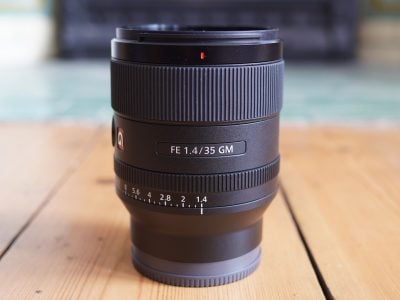Sony FE 35mm f1.4 GM review
-
-
Written by Gordon Laing
Intro
The Sony FE 35mm f1.4 G Master is a high-end wide-angle prime lens for Sony’s e-mount mirrorless system and one that’s corrected for full-frame bodies. Announced in January 2021, it costs around $1400.
The 35mm 1.4 GM actually becomes Sony’s fourth 35 in the native e-mount, but the first to join the flagship G-Master series. Sony’s first FE 35 was the FE 35mm 2.8 ZA, a collaboration with Zeiss to produce a compact, almost pancake prime to launch the A7 series back in 2013. This was followed by another Zeiss collaboration in 2015, the FE 35mm f1.4 ZA, which until now was Sony’s best 35. Then in 2019 came the FE 35mm f1.8, a more affordable option but with excellent results and I’ve linked here to our full reviews of each lens.
Now the latest FE 35 1.4 GM exploits Sony’s most recent lens technologies to take the performance even higher, especially when compared to the five year old Zeiss model. Indeed while the 35 GM launches at the same price as the old Zeiss version, expect the older lens to fall in price now there’s a new sheriff in town. In fact while there’s a wealth of alternative 35s in the e-mount, for me the biggest rival to Sony’s 35 GM at this price point becomes the Sigma 35mm f1.2 DG DN, costing roughly the same but boasting a brighter f1.2 aperture, albeit from a considerably heftier barrel. I’ll directly compare their quality and features throughout my video review below, but as always if you prefer to read a written version, keep scrolling for the highlights!
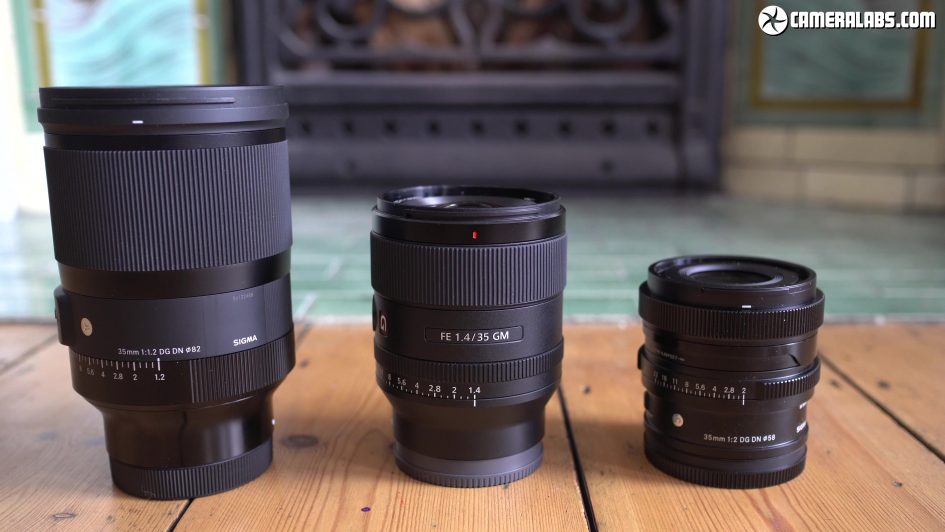
Above: Let’s have a look at them side-by-side for starters, with the Sony 35 GM in the middle, joined by the Sigma 35 1.2 on the left. The difference is dramatic: the Sigma is a relative giant, measuring 88x136mm versus 76x96mm for the Sony and is double the weight at 1090g compared to 524g. The filter thread is also unsurprisingly wider on the Sigma at 82mm compared to 67mm on the Sony. For good measure, I’ve also included Sigma’s latest 35mm f2 DG DN on the right which at 70x65mm and 325g is a smaller, lighter and more affordable option that goes up against Sony’s own 35 1.8, but let’s concentrate on the two premium models for this review.
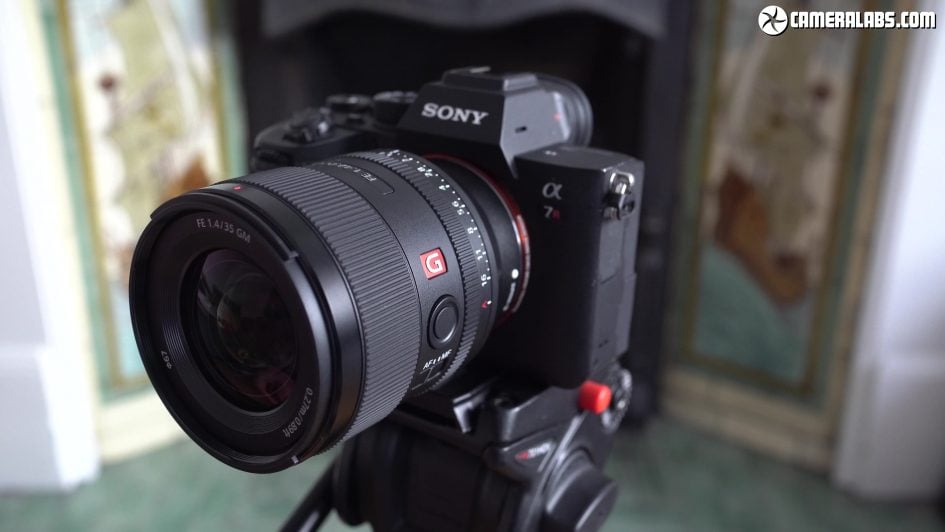
Above: Mounted on an A7 body you can really appreciate the compact size of the 35 GM – it’s very similar to the earlier 24 1.4 GM, one of my favourite lenses, and both exploit Sony’s latest optical technologies to achieve excellent results from surprisingly compact designs.
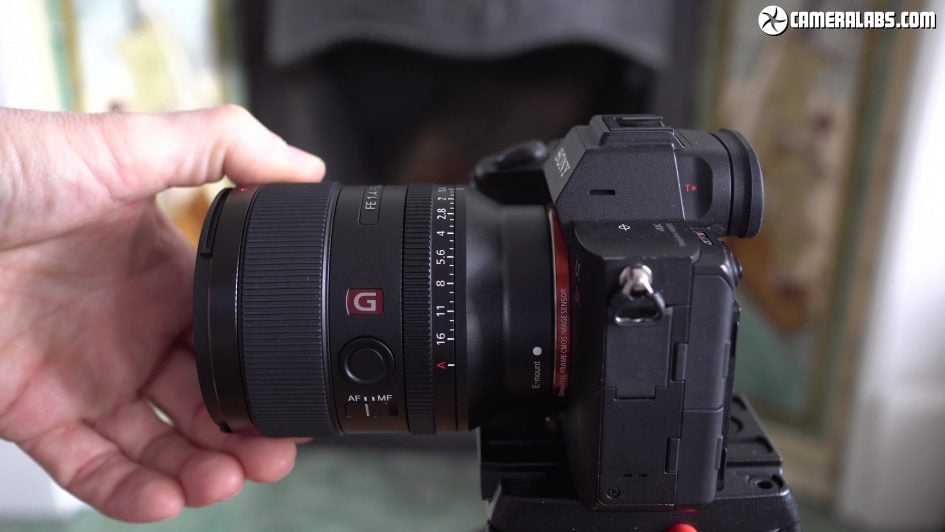
Above: The 35 GM has a customisable control button and an aperture ring running from f1.4 to f16, switchable between third-stop clicked intervals or smooth de-clicked operation that’s useful for video shooters. There’s a nicely damped and very smooth manual focusing ring with linear response. Sigma’s 35 1.2 also has a de-clickable aperture ring but slightly stiffer manual focusing.
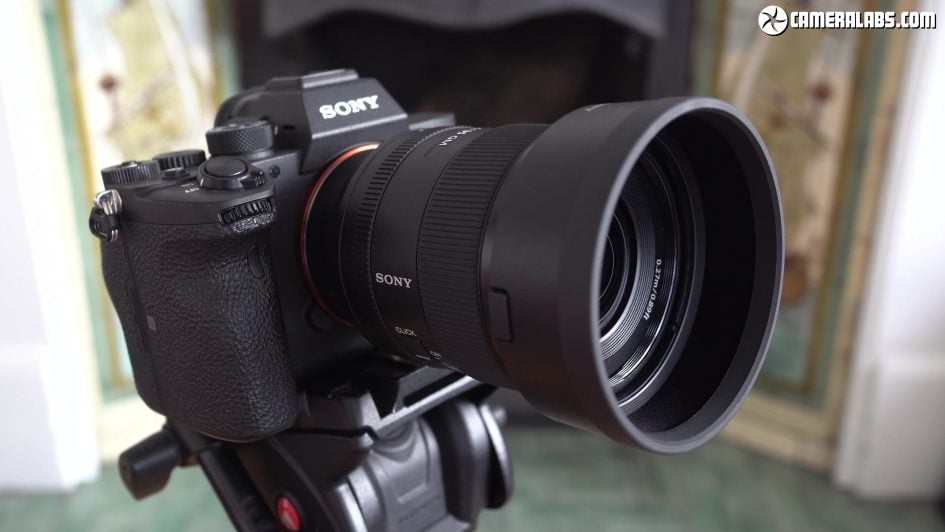
Above: Sony supplies the 35 1.4 GM with a cylindrical lens hood that twists on and can also be reversed over the barrel for transportation; note the considerate rubberised edge at the end which allows you to more securely place the lens upside down on a flat surface. In contrast, Sigma’s 35 1.2 has a petal hood that greatly increases its size and isn’t suitable for standing up. In fact the Sony fitted with its hood is still smaller than the Sigma without its hood. And as you’d expect for their price, both the Sony 35 1.4 GM and Sigma 35 1.2 are weather-sealed designs.
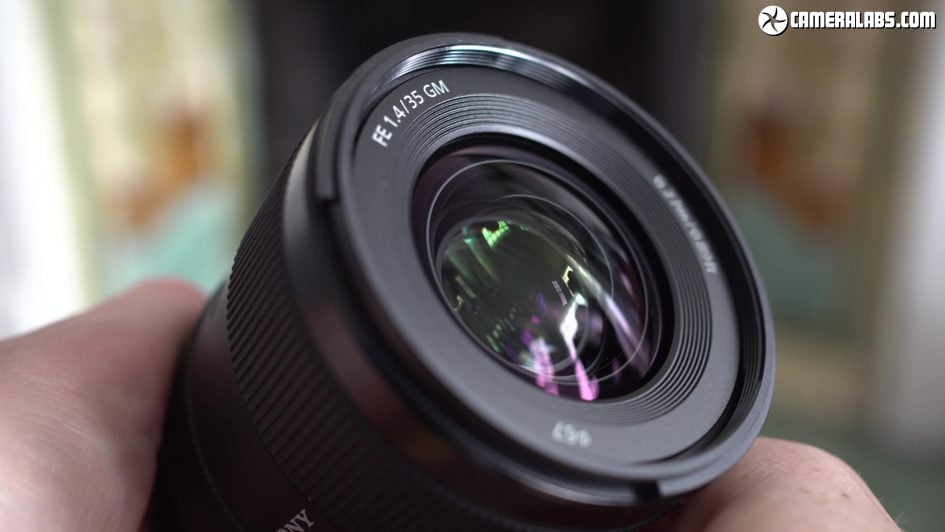
Above: The Sony 35 1.4 GM employs 14 elements in ten groups, including one extra-low dispersion element to reduce chromatic aberrations – or coloured fringing – and two extreme aspherical – or XA – elements to minimise coma, field curvature, and the onion-ring effect in bokeh blobs. Meanwhile Nano AR II coatings reduce internal reflections. XA elements and Nano AR II coatings didn’t exist when Sony and Zeiss designed the previous 35 1.4, so both are key improvements that allow the new lens to outperform the older model. Meanwhile there’s 11 aperture blades and a closest focusing distance of 27cm in AF or 25 when manually focusing.
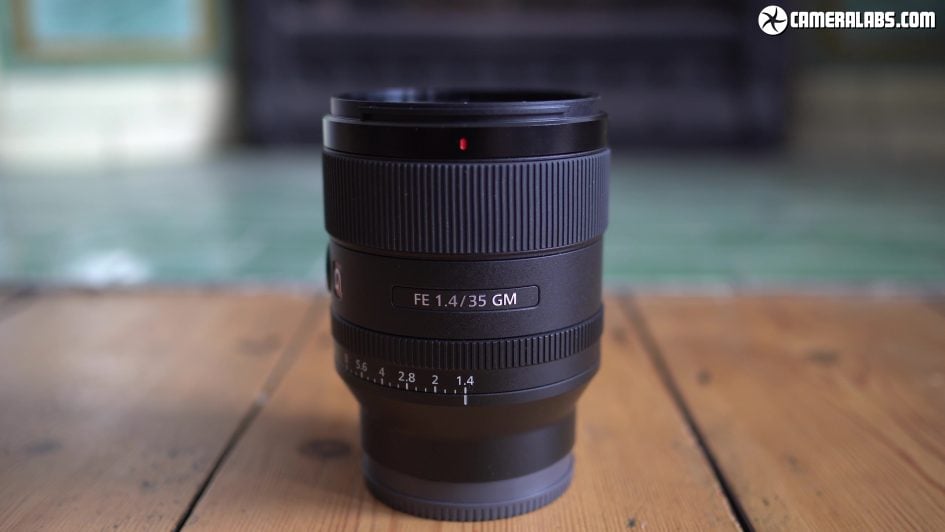
Above: The 35 1.4 GM employs a pair of XD linear motors for focusing which also didn’t exist back in 2015, and in my video review at the top of the page you can clearly see how the focusing is almost instant and feels very confident with little to no hesitation or hunting. Compare it to the Sigma 35 1.2, again wide-open, and you’ll notice the Sigma is visibly a little slower, while also hesitating from time to time when driven by this body. Don’t get me wrong, the Sigma’s AF performance is still very usable and would satisfy me in day-to-day use, but the new Sony is definitely quicker. Video focusing on the Sony lens is a little more leisurely, but no less confident, and the Sony lens is essentially silent in operation. Meanwhile the Sigma 35 1.2 was visibly less confident during movie AF in my tests. It’s as if the Sigma wasn’t exploiting the phase-detect AF of the A7r IV for video and instead reverting to a contrast-based system. This may be a firmware issue, but worth noting for video shooters. Meanwhile the focusing motors are just audible, but hardly obtrusive. That said, for quietness, accuracy and consistency, it’s a win for the Sony in terms of focusing.

Above: my next test is for rendering and bokeh blobs. I tested both lenses on an A7r IV and photographed this ornament from the same distance and at each of their apertures.Here’s the Sony 35 1.4 GM at f1.4.

Above: And now here’s the Sigma 35 1.2 at f1.2 for comparison, and the first thing you may notice is a difference in geometry with the Sigma looking a little less corrected with greater barrel distortion. This is using the default settings of the A7r IV which doesn’t apply correction to geometry on in-camera JPEGs unless you enable the feature. Now let’s put them side-by-side.
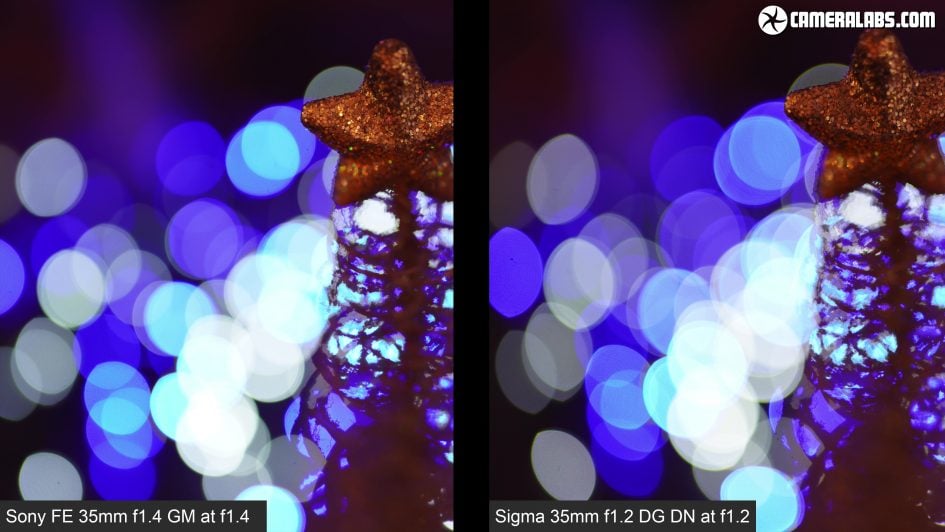
Above: With the Sony on the left at f1.4 and the Sigma on the right at f1.2, you’ll notice the blobs are a little larger on the Sigma when shot from the same distance. Both lenses are rendering nice-looking bokeh blobs at their maximum apertures and while their edges are crisp, there’s no harsh outlining. Look closely and you will notice very faint textures within the blobs, but nothing that could be described as distracting. Do you have a preference yet?
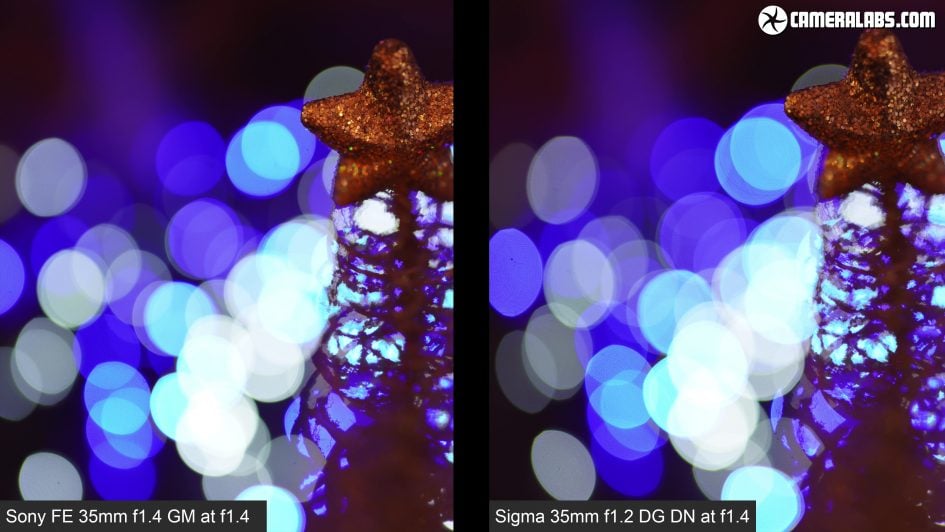
Above: Closing the Sigma on the right to f1.4 to match the aperture of the Sony, and you’ll notice the impact of its aperture blades, unceremoniously slicing the pointed ends from some of the oval blobs nearest the edges.
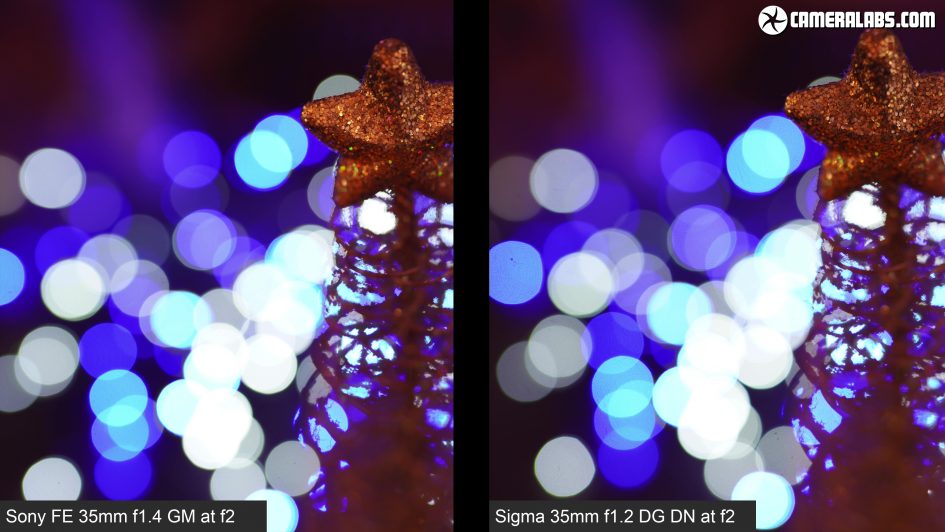
Above: With both lenses closed to f2, you’ll see their aperture blade systems are behaving well and rendering mostly rounded blobs which again look pretty similar in style and artefacts.
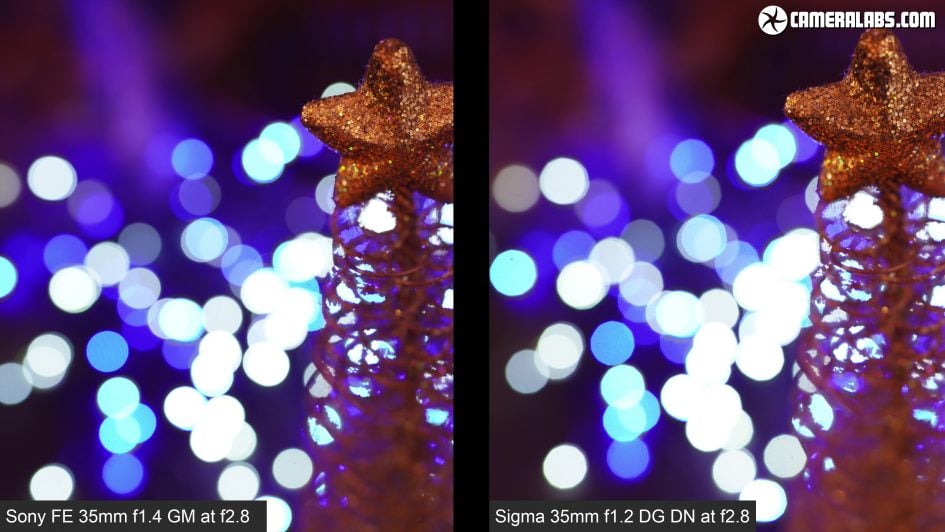
Above: Closed one stop further to f2.8, i’d say the aperture blade system of the Sigma on the right is now becoming more apparent, with a more obvious geometric shape to the blobs, compared to the Sony on the left which is still rendering mostly circular shapes.
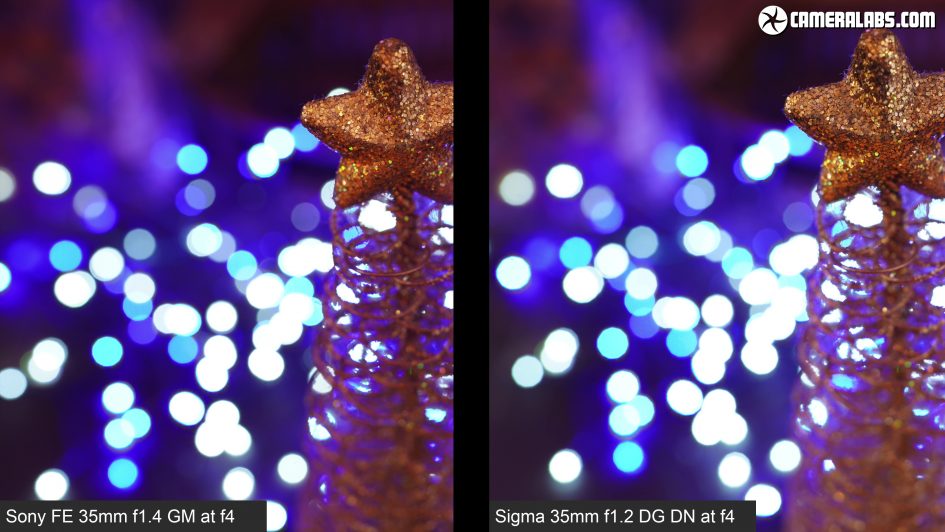
Above: Just one last bokeh blob comparison, this time at f4, which continues the story at previous apertures: so while both lenses are rendering blobs as eleven-sided geometric shapes, the Sigma on the right is more obvious in this regard, while the Sony on the left remains more circular. Technically this makes the Sony better-behaved, but you may prefer the shape of the Sigma blobs and to be fair, both lenses are looking good in this test. I think the key take-home here though is the difference between the Sigma at f1.2 and the Sony at f1.4 is pretty subtle.
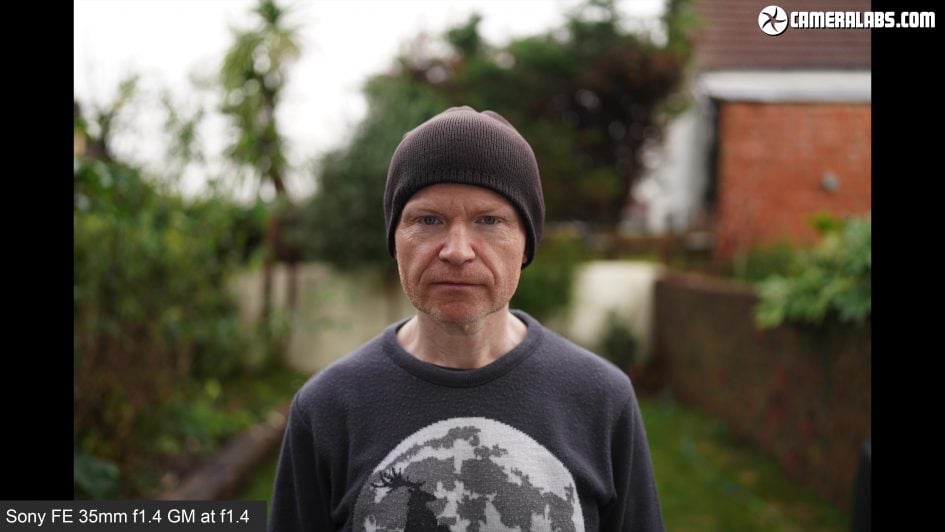
Above: Next for portraits, again with both lenses shooting from the same distance, starting with the Sony 35 1.4 GM at f1.4…
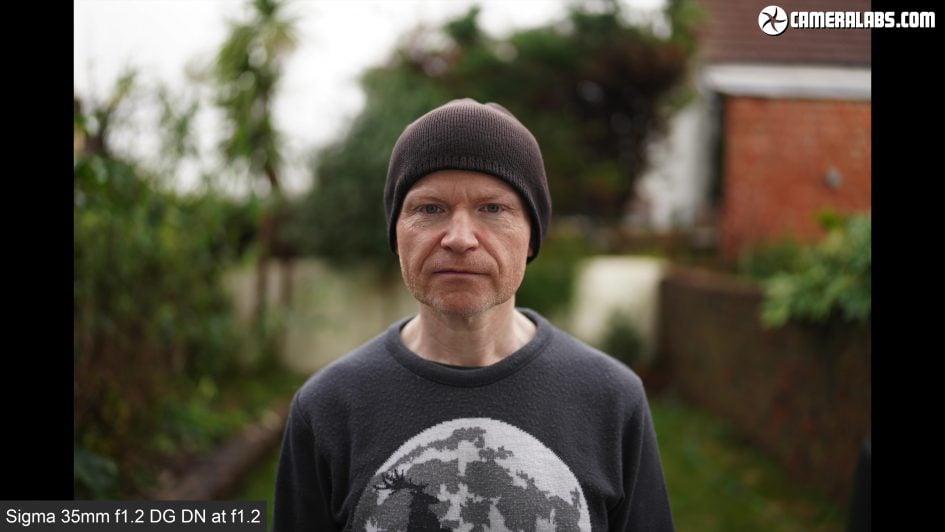
Above: …and now for the Sigma 35 1.2 at f1.2, and again as noted earlier you may notice more evidence of barrel distortion from the Sigma in the roof and guttering sloping in the upper right corner. Again this was using the default settings of the A7r IV which doesn’t apply geometric correction on in-camera JPEGs unless you enable it. I found enabling Distortion in the Lens Compensation menu can effectively straighten-up the Sigma – and of course you can also apply profiles after the event when processing RAW files – but in terms of pure optics, the Sony is better-corrected for geometry out of the gate.
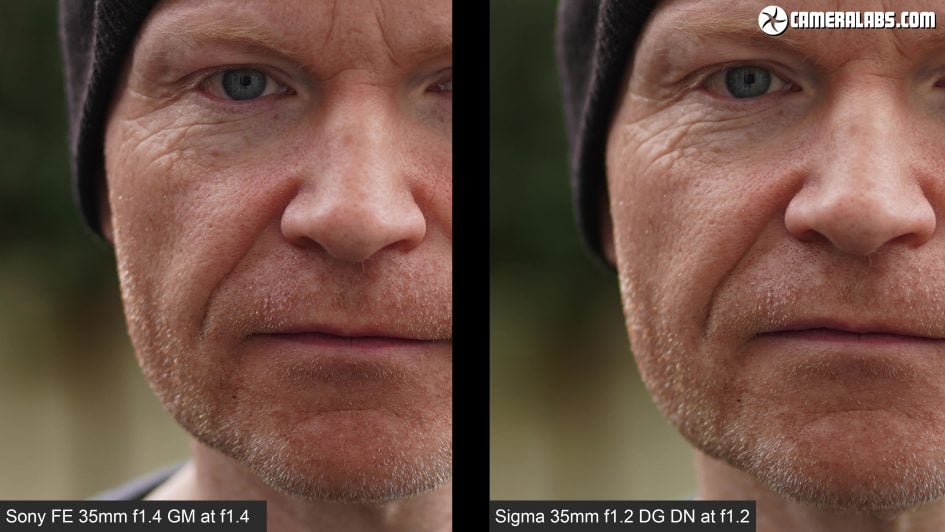
Above: Place the two portraits side by side at their maximum apertures and again there’s not much to choose between them. Both are capturing very sharp details on my face and while the Sony on the left is arguably a fraction crisper when pixel-peeping, there’s barely anything in it. In terms of rendering though, I’d say the fall-off looks a fraction softer on the Sigma on the right, but again not enough to make a decision over.
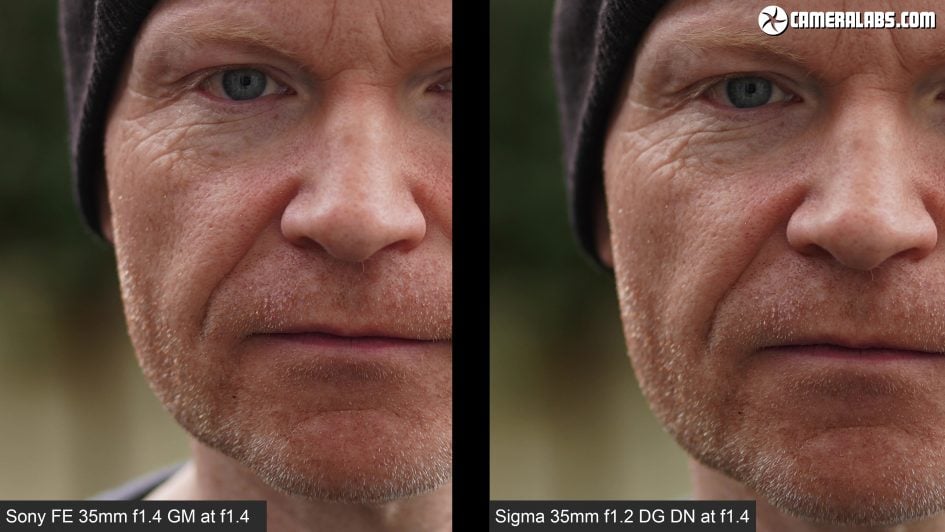
Above: Next here’s the Sigma on the right closed to f1.4 to match the maximum aperture of the Sony on the left. This brings the images even closer, although pixel-peepers may feel the Sony is fractionally more contrasty while the Sigma still has a slightly softer roll-off. Really not much between them though.
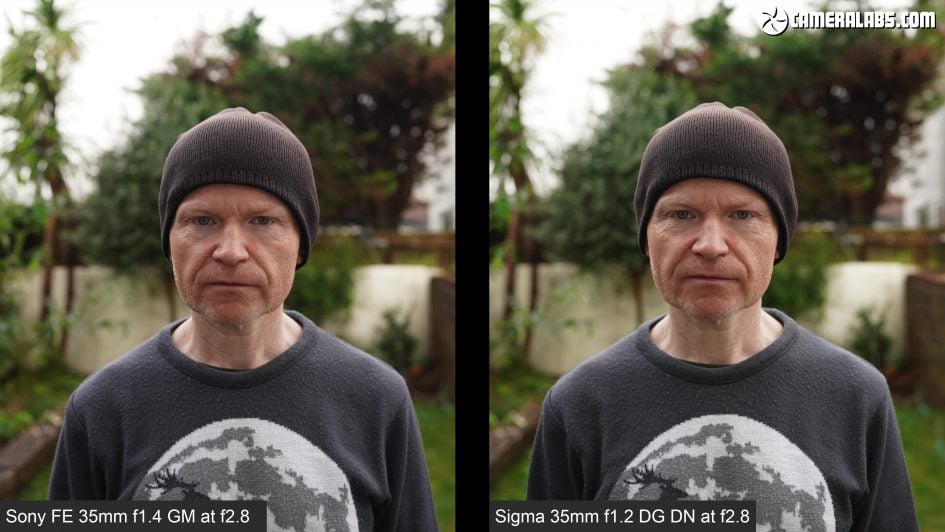
Above: And for those who prefer a broader depth-of-field, here they both are closed to f2.8, where the Sony on the left is again arguably a little crisper on the finest details, but again both are very capable lenses for this kind of thing.
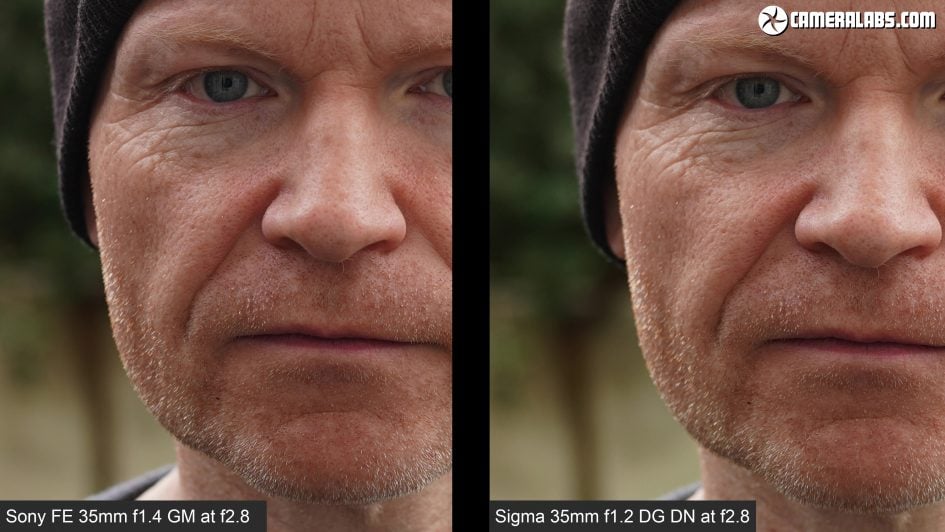
Above: Looking at the details and the rendering, do you have a preference between them?
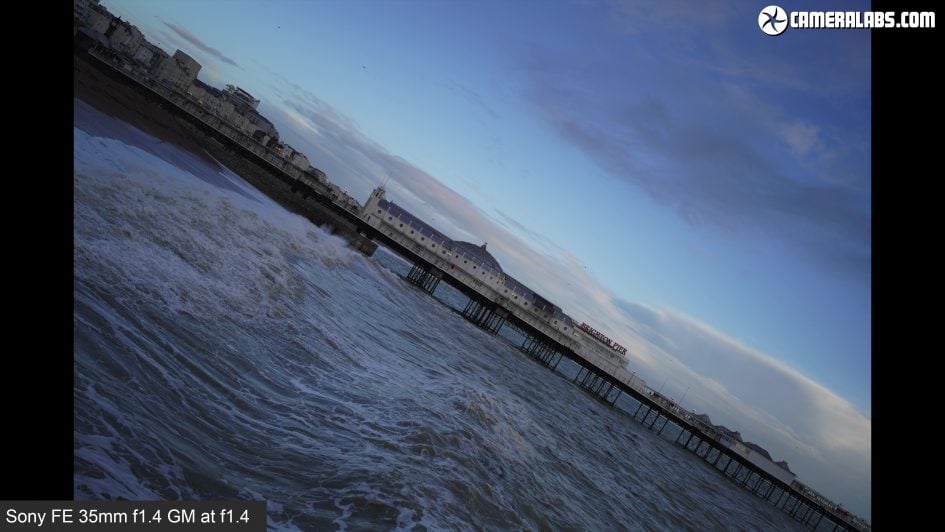
Above: For my third image quality comparison I photographed a distant subject with both lenses from the same position across their aperture ranges, focusing on the very centre of the composition with the A7r IV.
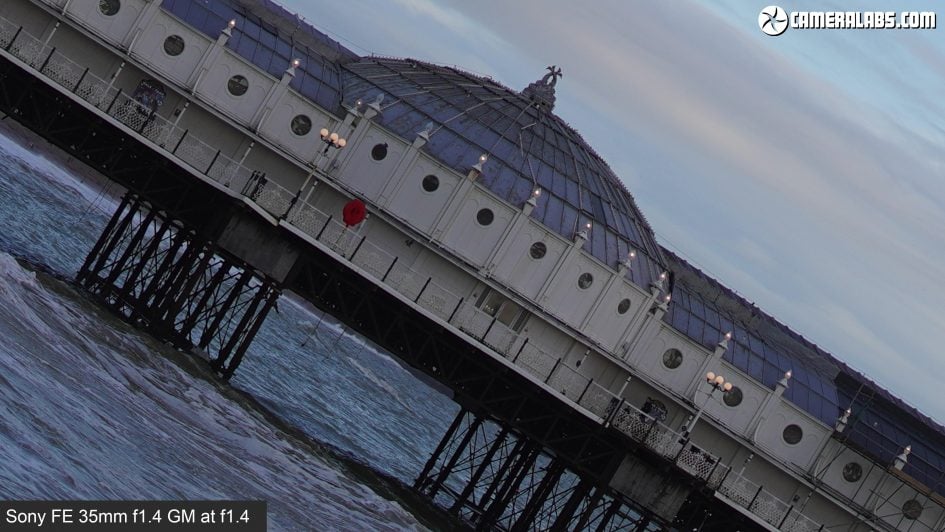
Above: So let’s start with the Sony 35 1.4 GM at f1.4 which, upon close inspection, reveals very fine details in the middle with its aperture wide-open – closing the aperture doesn’t make a significant difference here.
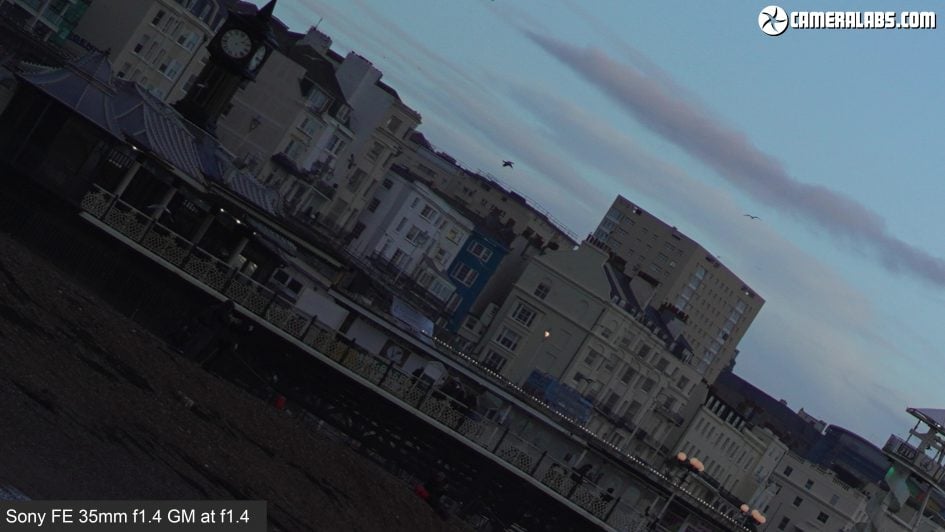
Above: Moving out to the extreme corners shows a very minor reduction in sharpness and a little darkening due to vignetting, but it still looks pretty good to me. Closing the aperture to f2 lifts the corner darkness and sharpens the details a little and there’s a further improvement at f2.8, but I’d say at this point the lens is already performing close to or at its best. Note the decorative LED lighting on the pier can be seen on some images but not on others due to its frequency, so try to ignore it.
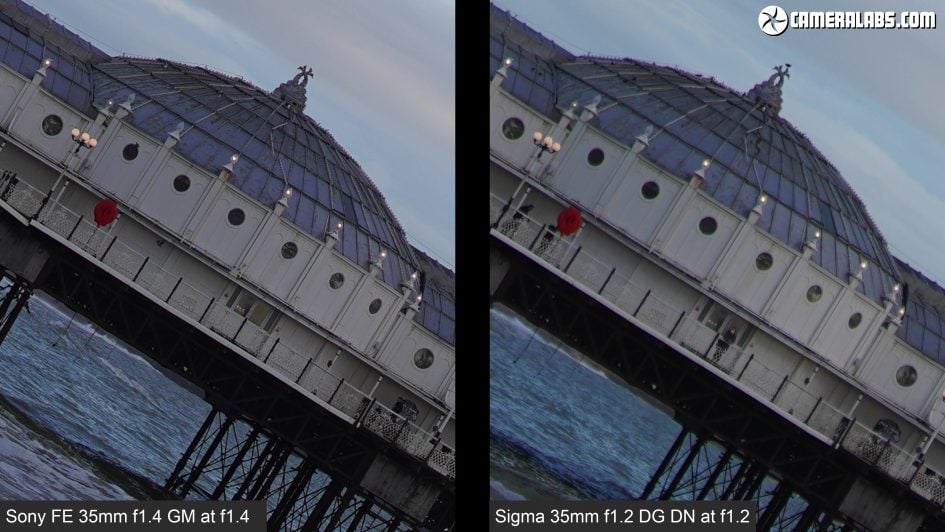
Above: Now for a side-by-side at their maximum apertures, with the Sony on the left and the Sigma on its right, starting with the middle. Upon close inspection the Sony on the left at f1.4 is clearly sharper than the Sigma on the right at f1.2, and I confirmed this by repeating the test several times.
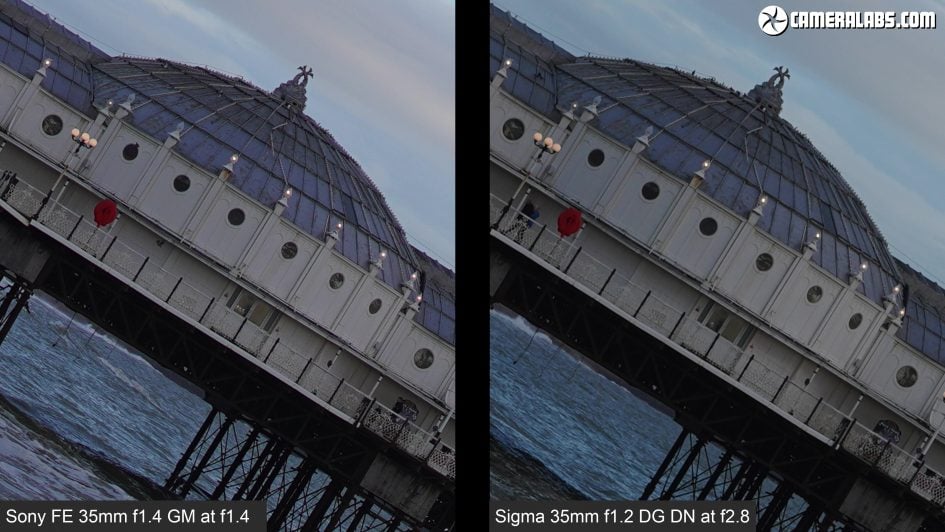
Above: If I keep the Sony at f1.4 on the left and gradually close the aperture on the Sigma on the right, you’ll see the Sigma steadily improve, coming close at f2 and essentially matching the Sony by f2.8 to f4.
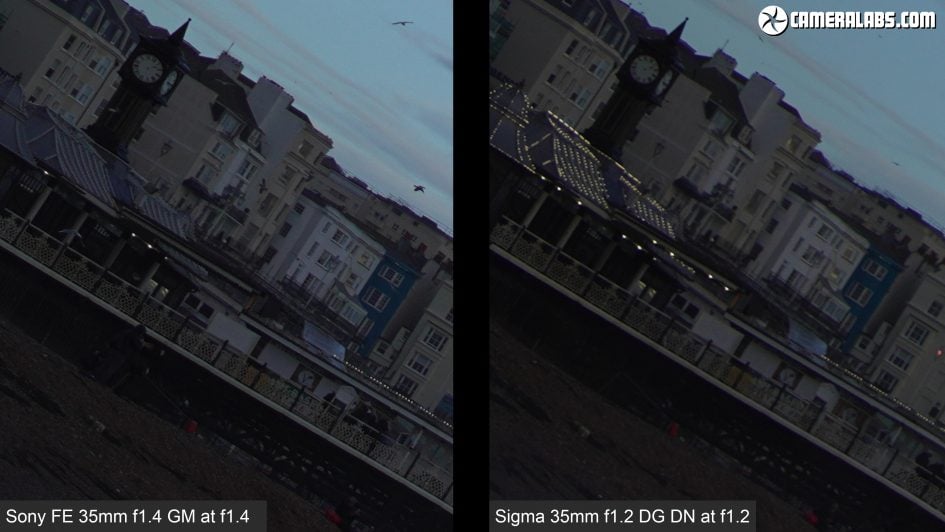
Above: Now let’s compare the corners, again starting with both lenses at their maximum apertures. While both are dimmer in the corners due to some vignetting, there’s no doubt the Sony on the left is sharper and better-corrected than the Sigma with less coma on the lights too. Closing the Sigma to f1.4 to match the maximum aperture of the Sony doesn’t make any difference here.
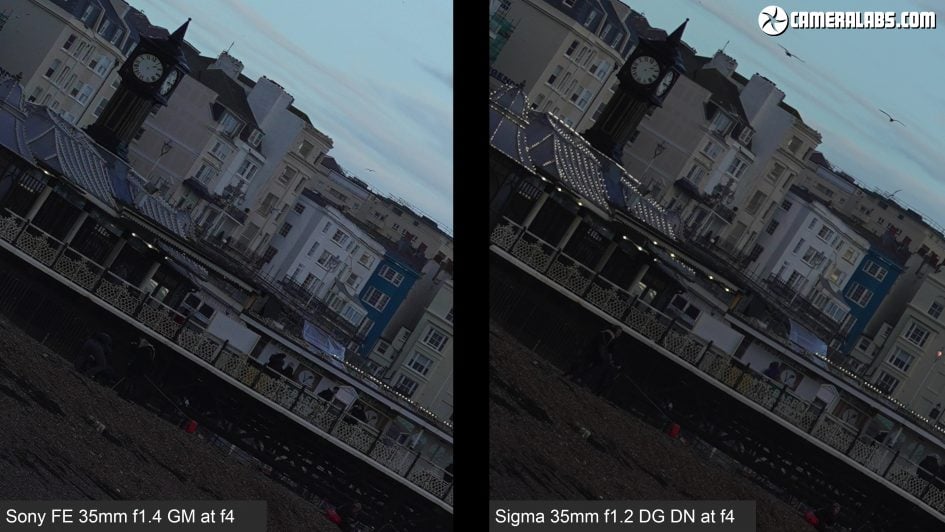
Above: To see the Sigma at its best in the corners, you’ll need to close it to f4, and I’ve done that for both lenses here for a direct comparison. I’d say the Sony still has an edge here, but again was noticeably better than the Sigma at larger apertures.
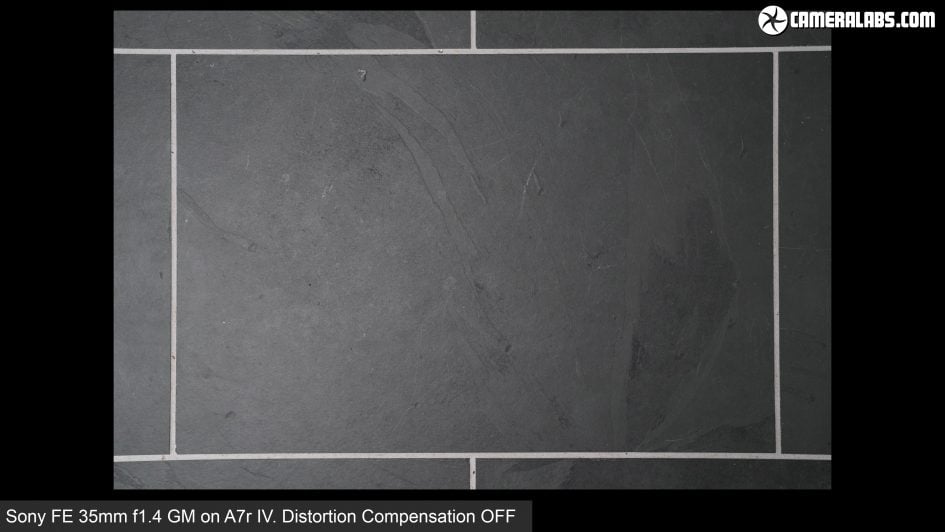
Above: Just before continuing, I wanted to briefly illustrate the geometric distortion I was mentioning earlier, so here’s a quick photo of a tile with the Sony 35 1.4 GM…
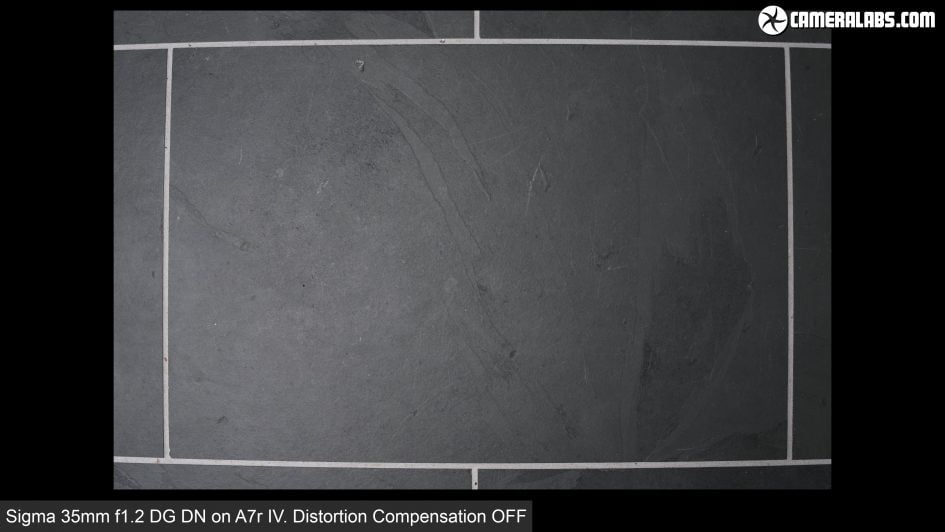
Above: …and now with the Sigma 35 1.2 where the barrel distortion is quite obvious. These were taken with the A7r IV’s default settings for JPEGs with Shading and CA compensation at Auto and Distortion set to OFF.
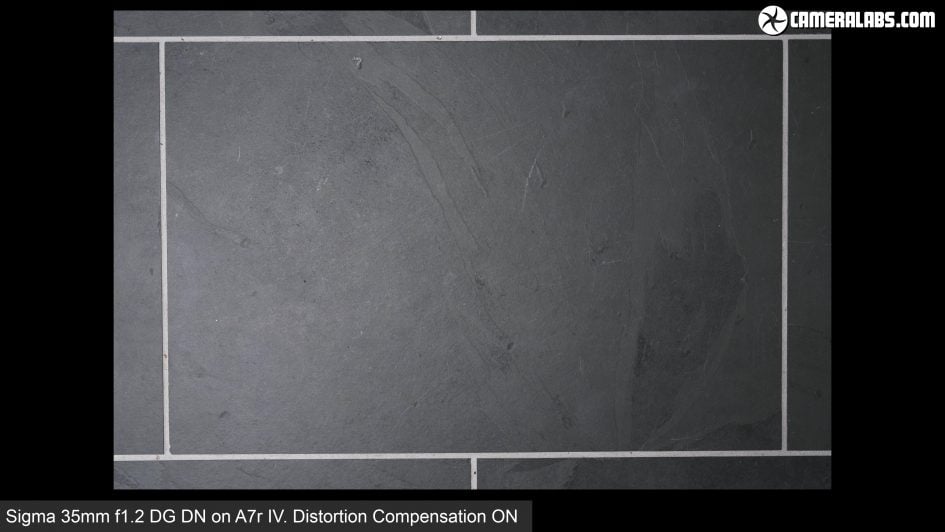
Above: But now here’s the Sigma 35 1.2 with Distortion compensation enabled in the menus where it corrects most of the barrelling effect. So optically the Sony exhibits much lower geometric distortion, but the Sigma can straighten-up nicely with digital compensation.
Check prices on the Sony FE 35mm f1.4 GM at B&H, Adorama, WEX or Calument.de! Alternatively get yourself a copy of my In Camera book or treat me to a coffee! Thanks!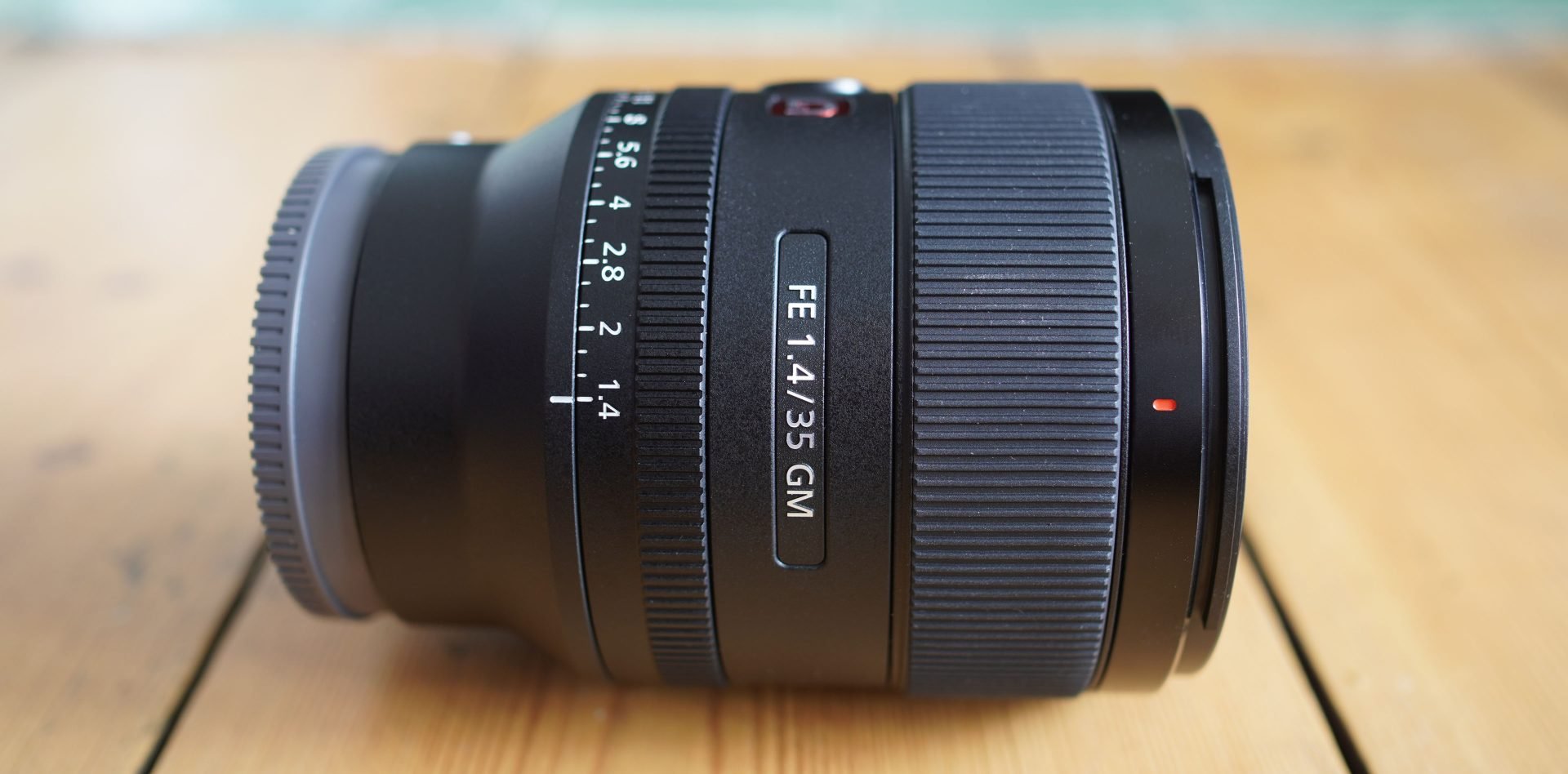
 The FE 35mm f1.4 G Master is Sony’s best 35 to date, exploiting their latest lens technologies to deliver superior results not only to the earlier 1.4 Zeiss version, but also more recent rivals including Sigma’s 35mm 1.2 DG DN. Details toward the centre are bitingly crisp, while the rendering of blurred areas is satisfyingly smooth with minimal outlining or textures in bokeh blobs. There’s little to no fringing, and the geometry is well-behaved even without compensation. Focusing is fast, accurate, consistent and operates in virtual silence, and the whole feature-set packaged in a compact weather-sealed barrel with a de-clickable aperture ring. I can’t think of anything to complain about and it’s a perfect example of how far lens design and construction has come in even the last five years since the Zeiss 35 1.4 which, lest we forget, most of us including myself were rather fond of. As such the 35 1.4 G Master confidently takes the crown as the best quality 35 in the Sony mount, although there are of course a multitude of alternatives if you’re happy with a slower aperture or have less to spend - for example Sony’s own 35 1.8 and Sigma’s 35 f2 DG DN are both great options at roughly half the price.
The FE 35mm f1.4 G Master is Sony’s best 35 to date, exploiting their latest lens technologies to deliver superior results not only to the earlier 1.4 Zeiss version, but also more recent rivals including Sigma’s 35mm 1.2 DG DN. Details toward the centre are bitingly crisp, while the rendering of blurred areas is satisfyingly smooth with minimal outlining or textures in bokeh blobs. There’s little to no fringing, and the geometry is well-behaved even without compensation. Focusing is fast, accurate, consistent and operates in virtual silence, and the whole feature-set packaged in a compact weather-sealed barrel with a de-clickable aperture ring. I can’t think of anything to complain about and it’s a perfect example of how far lens design and construction has come in even the last five years since the Zeiss 35 1.4 which, lest we forget, most of us including myself were rather fond of. As such the 35 1.4 G Master confidently takes the crown as the best quality 35 in the Sony mount, although there are of course a multitude of alternatives if you’re happy with a slower aperture or have less to spend - for example Sony’s own 35 1.8 and Sigma’s 35 f2 DG DN are both great options at roughly half the price.



